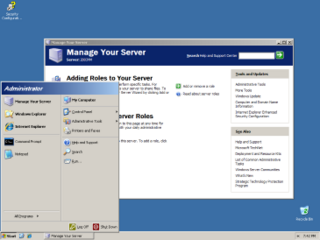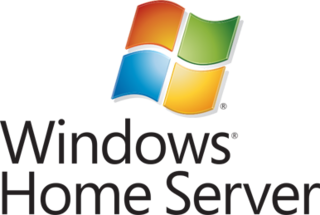Related Research Articles
Active Directory (AD) is a directory service developed by Microsoft for Windows domain networks. Windows Server operating systems include it as a set of processes and services. Originally, only centralized domain management used Active Directory. However, it ultimately became an umbrella title for various directory-based identity-related services.
Active Server Pages (ASP) is Microsoft's first server-side scripting language and engine for dynamic web pages.
VBScript is a deprecated Active Scripting language developed by Microsoft that is modeled on Visual Basic. It allows Microsoft Windows system administrators to generate powerful tools for managing computers without error handling and with subroutines and other advanced programming constructs. It can give the user complete control over many aspects of their computing environment.

Windows 2000 is a major release of the Windows NT operating system developed by Microsoft and designed for businesses. It was the direct successor to Windows NT 4.0, and was released to manufacturing on December 15, 1999, and was officially released to retail on February 17, 2000 and September 26, 2000 for Windows 2000 Datacenter Server. It was Microsoft's business operating system until the introduction of Windows XP Professional in 2001.

Windows Server 2003, codenamed "Whistler Server", is the second version of the Windows Server operating system produced by Microsoft. It is part of the Windows NT family of operating systems and was released to manufacturing on March 28, 2003 and generally available on April 24, 2003. Windows Server 2003 is the successor to the Server editions of Windows 2000 and the predecessor to Windows Server 2008. An updated version, Windows Server 2003 R2, was released to manufacturing on December 6, 2005. Windows Server 2003 is based on Windows 2000.

Internet Information Services is an extensible web server created by Microsoft for use with the Windows NT family. IIS supports HTTP, HTTP/2, HTTPS, FTP, FTPS, SMTP and NNTP. It has been an integral part of the Windows NT family since Windows NT 4.0, though it may be absent from some editions, and is not active by default.
NTLDR is the boot loader for all releases of Windows NT operating system from 1993 with the release of Windows NT 3.1 up until Windows XP and Windows Server 2003. From Windows Vista onwards it was replaced by the BOOTMGR bootloader. NTLDR is typically run from the primary storage device, but it can also run from portable storage devices such as a CD-ROM, USB flash drive, or floppy disk. NTLDR can also load a non NT-based operating system given the appropriate boot sector in a file.

In computing, configuration files are files used to configure the parameters and initial settings for some computer programs. They are used for user applications, server processes and operating system settings.
Integrated Windows Authentication (IWA) is a term associated with Microsoft products that refers to the SPNEGO, Kerberos, and NTLMSSP authentication protocols with respect to SSPI functionality introduced with Microsoft Windows 2000 and included with later Windows NT-based operating systems. The term is used more commonly for the automatically authenticated connections between Microsoft Internet Information Services, Internet Explorer, and other Active Directory aware applications.

The Windows Registry is a hierarchical database that stores low-level settings for the Microsoft Windows operating system and for applications that opt to use the registry. The kernel, device drivers, services, Security Accounts Manager, and user interfaces can all use the registry. The registry also allows access to counters for profiling system performance.
The Internet Server Application Programming Interface (ISAPI) is an n-tier API of Internet Information Services (IIS), Microsoft's collection of Windows-based web server services. The most prominent application of IIS and ISAPI is Microsoft's web server.
WebSphere Application Server (WAS) is a software product that performs the role of a web application server. More specifically, it is a software framework and middleware that hosts Java-based web applications. It is the flagship product within IBM's WebSphere software suite. It was initially created by Donald F. Ferguson, who later became CTO of Software for Dell. The first version was launched in 1998. This project was an offshoot from IBM HTTP Server team starting with the Domino Go web server.

Windows Server 2008, codenamed "Longhorn Server", is the fourth release of the Windows Server operating system produced by Microsoft as part of the Windows NT family of the operating systems. It was released to manufacturing on February 4, 2008, and generally to retail on February 27, 2008. Derived from Windows Vista, Windows Server 2008 is the successor of Windows Server 2003 and the predecessor to Windows Server 2008 R2.

Microsoft Management Console (MMC) is a component of Microsoft Windows that provides system administrators and advanced users an interface for configuring and monitoring the system. It was first introduced in 1998 with the Option Pack for Windows NT 4.0 and later came pre-bundled with Windows 2000 and its successors.
SQL Server Reporting Services (SSRS) is a server-based report generating software system from Microsoft. It is part of a suite of Microsoft SQL Server services, including SSAS and SSIS.

Windows Home Server is a home server operating system from Microsoft. It was announced on 7 January 2007 at the Consumer Electronics Show by Bill Gates, released to manufacturing on 16 July 2007 and officially released on 4 November 2007.
Windows Vista contains a range of new technologies and features that are intended to help network administrators and power users better manage their systems. Notable changes include a complete replacement of both the Windows Setup and the Windows startup processes, completely rewritten deployment mechanisms, new diagnostic and health monitoring tools such as random access memory diagnostic program, support for per-application Remote Desktop sessions, a completely new Task Scheduler, and a range of new Group Policy settings covering many of the features new to Windows Vista. Subsystem for UNIX Applications, which provides a POSIX-compatible environment is also introduced.

SharePoint is a proprietary, web-based collaborative platform that integrates natively with Microsoft 365. Launched in 2001, It allows organisations to create, manage, and share content and resources. It's often used for building intranet portals, document management, and team collaboration spaces. The platform integrates with Microsoft Office and offers features like workflow automation, data storage, and business intelligence tools. It's highly customizable, enabling businesses to tailor the experience to meet specific needs and industry requirements. With SharePoint Online, businesses can access company data from anywhere, facilitating remote work and improving productivity.

Server Core is a minimalistic Microsoft Windows Server installation option, debuted in Windows Server 2008. Server Core provides a server environment with functionality scaled back to core server features, and because of limited features, it has reduced servicing and management requirements, attack surface, disk and memory usage. Andrew Mason, a program manager on the Windows Server team, noted that a primary motivation for producing a Server Core variant of Windows Server 2008 was to reduce the attack surface of the operating system, and that about 70% of the security vulnerabilities in Microsoft Windows from the prior five years would not have affected Server Core. Most notably, no Windows Explorer shell is installed. All configuration and maintenance is done entirely through command-line interface windows, or by connecting to the machine remotely using Microsoft Management Console (MMC), remote server administration tools, and PowerShell.
References
- ↑ The Microsoft IIS Team (2004). Internet Information Services (IIS) 6.0 Resource Kit. Redmond, Wash: Microsoft Press. pp. 513–564. ISBN 0-7356-1420-2.
- ↑ "Overview of the IIS 6.0 Metabase". Microsoft Corporation. 2005-08-22. Archived from the original on 2007-08-16. Retrieved 2007-09-10.
- ↑ "How to Enable the Enable Direct Metabase Edit Feature in IIS Manager". Microsoft Corporation. 2005-05-23. Retrieved 2007-09-10.